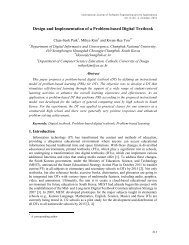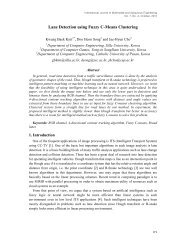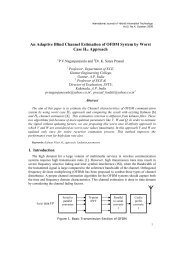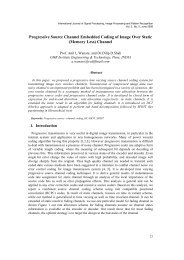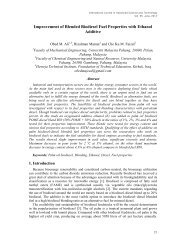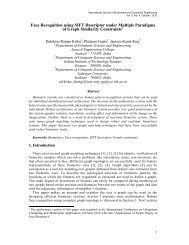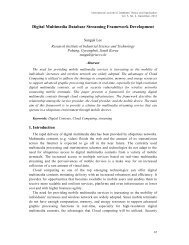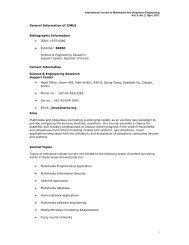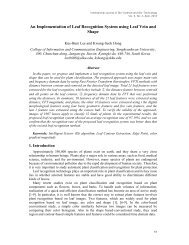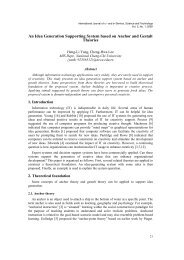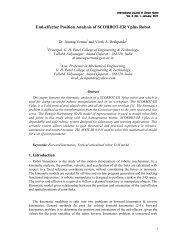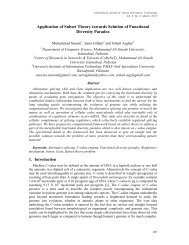A Communication Protocol of RFID Systems in Internet of Things
A Communication Protocol of RFID Systems in Internet of Things
A Communication Protocol of RFID Systems in Internet of Things
You also want an ePaper? Increase the reach of your titles
YUMPU automatically turns print PDFs into web optimized ePapers that Google loves.
International Journal <strong>of</strong> Security and Its Applications<br />
Vol. 6, No. 2, April, 2012<br />
A <strong>Communication</strong> <strong>Protocol</strong> <strong>of</strong> <strong>RFID</strong> <strong>Systems</strong> <strong>in</strong> <strong>Internet</strong> <strong>of</strong> Th<strong>in</strong>gs<br />
HuiDan Gao,YaJun Guo*,JianQun Cui, HengGeng Hao and Hui Shi<br />
Department <strong>of</strong> Computer Science, Central Ch<strong>in</strong>a Normal University<br />
Wuhan 430079, Ch<strong>in</strong>a<br />
ccnugyj@126.com,gaodan8703@126.com<br />
Abstract<br />
Radio frequency identification (<strong>RFID</strong>) is one <strong>of</strong> the key technologies which constitute<br />
<strong>in</strong>ternet <strong>of</strong> th<strong>in</strong>gs. Security and privacy issues <strong>of</strong> <strong>RFID</strong> systems is the focus <strong>of</strong> the present<br />
study. By analyz<strong>in</strong>g several typical <strong>RFID</strong> security protocols, for the special security<br />
requirements <strong>of</strong> <strong>RFID</strong> systems <strong>in</strong> <strong>in</strong>ternet <strong>of</strong> th<strong>in</strong>gs, <strong>in</strong> the paper, we propose a<br />
communication protocol SPAP(security-provable authentication protocol), then analyze and<br />
demonstrate the security <strong>of</strong> the protocol <strong>in</strong> details by the random oracle model. Analysis show<br />
that the protocol not only can solve the tag track<strong>in</strong>g, replay attack, clon<strong>in</strong>g attack and the tag<br />
<strong>in</strong>formation <strong>in</strong>dist<strong>in</strong>guishable, but also can solve the <strong>in</strong>ternal attack and the ownership<br />
transfer <strong>of</strong> tags and other issues <strong>of</strong> <strong>RFID</strong> <strong>Systems</strong> <strong>in</strong> <strong>in</strong>ternet <strong>of</strong> th<strong>in</strong>gs. F<strong>in</strong>ally, accord<strong>in</strong>g to<br />
the comparisons, SPAP has the best performance.<br />
Keywords: <strong>Internet</strong> <strong>of</strong> Th<strong>in</strong>gs; <strong>RFID</strong>; EPC; SPAP; Random oracle model.<br />
1. Introduction<br />
<strong>Internet</strong> <strong>of</strong> Th<strong>in</strong>gs is one <strong>of</strong> the hottest topics <strong>in</strong> the IT <strong>in</strong>dustry, is the mature stage <strong>of</strong> the<br />
development <strong>of</strong> <strong>Internet</strong>. This means it can appear at any time, any place, any object can be<br />
l<strong>in</strong>ked with this ubiquitous network. Although the concept <strong>of</strong> <strong>in</strong>ternet <strong>of</strong> th<strong>in</strong>gs has been<br />
widely recognized, scholars from worldwide have been study<strong>in</strong>g and promot<strong>in</strong>g its<br />
application all the time, the development <strong>of</strong> <strong>in</strong>ternet <strong>of</strong> th<strong>in</strong>gs still faces many difficulties,<br />
especially the privacy issues <strong>in</strong> the <strong>RFID</strong> systems.<br />
<strong>RFID</strong> systems <strong>in</strong> <strong>in</strong>ternet <strong>of</strong> th<strong>in</strong>gs[1,2] consist <strong>of</strong> readers, EPC tags, <strong>RFID</strong> middleware<br />
components. The wireless data communication technology between EPC tags and readers can<br />
make the systems vulnerable to retransmit, track, tamper, counterfeit. In addition, security<br />
issues <strong>of</strong> the ownership transfer <strong>of</strong> tags are also very important, design<strong>in</strong>g safe and efficient<br />
<strong>RFID</strong> security systems is necessary for <strong>in</strong>ternet <strong>of</strong> th<strong>in</strong>gs. The methods to achieve the security<br />
<strong>of</strong> <strong>RFID</strong> systems conclude physical methods, password mechanisms and comb<strong>in</strong>ation <strong>of</strong><br />
them. As physical methods are defective, security mechanisms bas<strong>in</strong>g on the password<br />
technology are the focus <strong>of</strong> today's researches. Currently, there are varieties <strong>of</strong> <strong>RFID</strong> security<br />
protocols that have been proposed, but the protocols have their own shortcom<strong>in</strong>gs. To date,<br />
there is not a specific security protocol to meet all the security requirements <strong>of</strong> <strong>RFID</strong> systems<br />
<strong>of</strong> <strong>in</strong>ternet <strong>of</strong> th<strong>in</strong>gs. What’s more, us<strong>in</strong>g the theory <strong>of</strong> provable security to prove the security<br />
authentication protocol is an important research direction, however, the example <strong>of</strong> us<strong>in</strong>g the<br />
provable security theory to analyze security authentication <strong>RFID</strong> protocol is very poor. For<br />
solv<strong>in</strong>g the above problems, this paper presents a security authentication that can be<br />
successfully used <strong>in</strong> <strong>RFID</strong> systems <strong>of</strong> <strong>in</strong>ternet <strong>of</strong> th<strong>in</strong>gs, and proves its safety by the random<br />
oracle model [3].<br />
This paper is constructed as follows: Section 2 analyses and compares the exist<strong>in</strong>g typical<br />
<strong>RFID</strong> security protocols. Section 3 describes the model <strong>of</strong> <strong>RFID</strong> systems <strong>of</strong> <strong>in</strong>ternet <strong>of</strong> th<strong>in</strong>gs,<br />
91
International Journal <strong>of</strong> Security and Its Applications<br />
Vol. 6, No. 2, April, 2012<br />
and def<strong>in</strong>es its security needs. Section 4 proposes a Provable Secure Authentication SPAP,<br />
and proves its security. Section 5 analyses the performance <strong>of</strong> SPAP. Section 6 makes a<br />
conclusion.<br />
2. The Exist<strong>in</strong>g Typical <strong>RFID</strong> Security <strong>Protocol</strong><br />
Today, <strong>RFID</strong> technology has been widely used <strong>in</strong> many areas because <strong>of</strong> its strong<br />
anti-<strong>in</strong>terference, easy operation, etc. At the same time, security and privacy issues <strong>of</strong><br />
<strong>RFID</strong> system are <strong>in</strong>creas<strong>in</strong>gly exposed. Scholars from various countries <strong>in</strong> the world try<br />
their best to make a series <strong>of</strong> solutions, such as the Hash-Lock protocol bas<strong>in</strong>g on hash<br />
functions and random numbers [4], the randomized Hash-Lock protocol[5];the library<br />
<strong>RFID</strong> protocol bas<strong>in</strong>g on shared pseudo and random function keys[6]; the Ownership<br />
Transfer <strong>Protocol</strong> bas<strong>in</strong>g on symmetric key algorithms[7]; and EC-RAC protocol bas<strong>in</strong>g<br />
on public key cryptography algorithms[8].<br />
The Hash-Lock protocol uses hash functions to implement the authentication between<br />
readers and tags, us<strong>in</strong>g metal ID <strong>in</strong>stead <strong>of</strong> the real ID to solve the track<strong>in</strong>g attacks, but<br />
the protocol does not use the dynamic ID mechanism, thus an attacker can still replay<br />
attacks, and track attacks. The randomized Hash-Lock protocol can resist the tag<br />
track<strong>in</strong>g attacks, but after the certification, the tag ID can still pass through the clear<br />
text form, an attacker can still replay attacks. The Library <strong>RFID</strong> protocol adopts the<br />
pre-shared key, pseudo-random function to achieve authentication, to solve the<br />
retransmission, track<strong>in</strong>g, tamper<strong>in</strong>g and other security issues, so far, no obvious defects<br />
<strong>of</strong> the protocol are found, but the cost <strong>of</strong> labels is too high. Ownership Transfer<br />
protocol us<strong>in</strong>g symmetric encryption algorithms solves the tamper<strong>in</strong>g, track<strong>in</strong>g and<br />
ownership transfer <strong>of</strong> the tag, but it cannot achieve forward security. EC-RAC protocol<br />
us<strong>in</strong>g elliptic curve public key cryptography algorithms solves the label track<strong>in</strong>g<br />
attacks, protects the security <strong>of</strong> the system, however, recent experiments reveal that the<br />
protocol still cannot resist track<strong>in</strong>g attacks.<br />
The <strong>in</strong>ternet <strong>of</strong> th<strong>in</strong>gs asks for even more special security requirements for its <strong>RFID</strong><br />
system. The connection between tags and readers <strong>in</strong> <strong>in</strong>ternet <strong>of</strong> th<strong>in</strong>gs makes the<br />
protocol take <strong>in</strong>to account <strong>of</strong> <strong>in</strong>ternal attacks <strong>of</strong> the systems, as well as the ownership<br />
transfer <strong>of</strong> tags [9]. By analyz<strong>in</strong>g the above protocols, this paper establishes a model <strong>of</strong><br />
the <strong>RFID</strong> system <strong>in</strong> <strong>in</strong>ternet <strong>of</strong> th<strong>in</strong>gs, def<strong>in</strong>es their security requirements, and proposes<br />
a new security protocol.<br />
3. The Model and Security Requirements <strong>of</strong> <strong>RFID</strong> System <strong>in</strong> <strong>Internet</strong> <strong>of</strong><br />
Th<strong>in</strong>gs<br />
3.1 The <strong>RFID</strong> System Model <strong>of</strong> <strong>Internet</strong> <strong>of</strong> Th<strong>in</strong>gs<br />
<strong>RFID</strong> systems <strong>in</strong> <strong>in</strong>ternet <strong>of</strong> th<strong>in</strong>gs ma<strong>in</strong>ly consist <strong>of</strong> readers, tags and <strong>RFID</strong> middle<br />
wares. Each object <strong>in</strong> the system has an unique EPC. We assume that <strong>in</strong> one <strong>RFID</strong><br />
system there are N legitimate readers numbered from 1 to N , there are M legitimate<br />
readers numbered from 1 to M . i (1, N)<br />
, j (1, M)<br />
,the reader i is denoted as R i<br />
,the<br />
tag j is denoted as T j<br />
.In addition, because the cable channels between the reader and<br />
database are generally considered safe, therefore, when we establish the model, the<br />
reader and database can be seen as a unified <strong>in</strong>dependent entity, that is, the reader and<br />
database are collectively referred to as the middleware server.<br />
92
International Journal <strong>of</strong> Security and Its Applications<br />
Vol. 6, No. 2, April, 2012<br />
Random Oracle model [10] is applied to describe the <strong>RFID</strong> system model <strong>in</strong> <strong>in</strong>ternet<br />
<strong>of</strong> th<strong>in</strong>gs. The model can be equivalent to a tuple P ( )<br />
, and are time<br />
functions <strong>of</strong> polynomial whose safety factor is 1 k ( k<br />
N)<br />
, def<strong>in</strong>es the behavior <strong>of</strong> a<br />
legitimate reader, def<strong>in</strong>es the operation <strong>of</strong> a legitimate tag. Us<strong>in</strong>g the random Oracle to<br />
query and def<strong>in</strong>ite the behavior <strong>of</strong> an attacker, that is, the attacker which has Oracle<br />
s<br />
s<br />
<br />
R i,T<br />
( R<br />
j i<br />
<strong>in</strong>itiates a session s with T j<br />
) and Oracle <br />
Tj,R<br />
( T<br />
i j<br />
<strong>in</strong>itiates a session s<br />
with R i<br />
)is an Oracle probability mach<strong>in</strong>e. The attacker can achieve the attack target by<br />
s<br />
s<br />
send<strong>in</strong>g scheduled questions to Oracle R i,T<br />
and Oracle <br />
j<br />
Tj,R<br />
and receiv<strong>in</strong>g response<br />
i<br />
<strong>in</strong>formation from the random Oracle. Oracle question depicts the real ability <strong>of</strong> the<br />
attacker. The attacker can send the follow<strong>in</strong>g questions.<br />
Execute ( R <br />
T<br />
, P)<br />
: the question depicts an <strong>in</strong>stance P that the attacker execute the<br />
i j<br />
protocol between T j<br />
and R i<br />
which can obta<strong>in</strong> all messages exchanged between the<br />
reader and the tag when the protocol P executes.<br />
SendTag ( <br />
T<br />
, Pm ,<br />
1)<br />
: the question depicts an <strong>in</strong>stance P that the attacker A sends the<br />
j<br />
message m<br />
1<br />
to tag T j<br />
, and receives the response message <strong>of</strong> the tag T j<br />
.<br />
SendReader ( <br />
R<br />
, Pm ,<br />
2)<br />
:the question depicts <strong>in</strong>stance P that the attacker A sends the<br />
i<br />
message m2<br />
to reader R i<br />
, and receives the response message <strong>of</strong> the reader R i<br />
.<br />
CorruptTag ( ):the question depicts an active attack on the tag and the attacker's<br />
Tj<br />
captured capacity. It can make the captured tag T j<br />
actively reveal secret <strong>in</strong>formation<br />
which is <strong>in</strong> their private storage space.<br />
CorruptRead ( ):the question depicts an active attack on the reader and the attacker's<br />
Ri<br />
captured capacity. It can make the captured reader R i<br />
actively reveal secret <strong>in</strong>formation which<br />
is <strong>in</strong> their private storage space.<br />
Test ( ):the question is used to test semantic security <strong>of</strong> confidential <strong>in</strong>formation <strong>of</strong> a tag<br />
Tj<br />
T j<br />
. By throw<strong>in</strong>g co<strong>in</strong> b , if b = 1, return the secret <strong>in</strong>formation stored <strong>in</strong> the tag. if b = 0,<br />
return an random number which is equivalent <strong>in</strong> length to the secret <strong>in</strong>formation <strong>of</strong> the tag.<br />
Test ( ):the question is used to test semantic security <strong>of</strong> confidential <strong>in</strong>formation <strong>of</strong><br />
Ri<br />
a reader R i<br />
.By throw<strong>in</strong>g co<strong>in</strong> b , if b = 1, return the secret <strong>in</strong>formation stored <strong>in</strong> the<br />
tag. if b = 0, return an random number which is equivalent <strong>in</strong> length to the secret<br />
<strong>in</strong>formation <strong>of</strong> the reader.<br />
3.2 Security Requirements <strong>of</strong> Authentication <strong>in</strong> <strong>RFID</strong> System <strong>of</strong> <strong>Internet</strong> <strong>of</strong> Th<strong>in</strong>gs<br />
An <strong>RFID</strong> system is an important part <strong>of</strong> <strong>in</strong>ternet <strong>of</strong> th<strong>in</strong>gs, non-contact automatic<br />
identification technology between the reader and the tag <strong>in</strong> the system which makes the<br />
system face serious security problems. Analyz<strong>in</strong>g the security needs met by exist<strong>in</strong>g typical<br />
<strong>RFID</strong> protocols and comb<strong>in</strong><strong>in</strong>g the characteristics <strong>of</strong> <strong>RFID</strong> system <strong>of</strong> <strong>in</strong>ternet <strong>of</strong> th<strong>in</strong>gs, what<br />
needs the authentication should meet <strong>in</strong> <strong>RFID</strong> system <strong>of</strong> <strong>in</strong>ternet <strong>of</strong> th<strong>in</strong>gs are detailed <strong>in</strong> the<br />
follow<strong>in</strong>g.<br />
93
International Journal <strong>of</strong> Security and Its Applications<br />
Vol. 6, No. 2, April, 2012<br />
Def<strong>in</strong>ition1. If for any polynomial PK ( ) and sufficiently large K ,the function can<br />
satisfy ( ) <br />
, then we say that the function can be negligible.<br />
Mutual authentication: The tag should be able to achieve the certification <strong>of</strong> legitimate<br />
reader, that is, if the attacker R achieves tag T<br />
j<br />
( j[1, M])<br />
to certificate for R i<br />
by fabricat<strong>in</strong>g<br />
reader R ( a a<br />
[1, N ]) ,we denote it as Adv( R ) . Then the probability <strong>of</strong> success <strong>of</strong> R is<br />
Pr(Adv( R)) ( K)<br />
. The reader should be able to achieve the certification <strong>of</strong> legitimate tag,<br />
that is, if the attacker T achieves reader R<br />
i<br />
( i[1, N])<br />
to certificate for T j<br />
by fabricat<strong>in</strong>g<br />
legitimate tag T ( b b<br />
[1, M ]) , we denote it as Adv( T ) . Then the success probability <strong>of</strong> T is<br />
Pr(Adv( T) ( K)<br />
.<br />
Forward security: Even if an attacker obta<strong>in</strong>s the tag status <strong>of</strong> its current time t 1<br />
, the<br />
attacker cannot connect the status with the tag status obta<strong>in</strong>ed <strong>in</strong> previous one time<br />
t1 ( t1 t2)<br />
.That is, to j [1, M]<br />
, t 1<br />
t 2<br />
, the attacker Q has already known the <strong>in</strong>formation <strong>of</strong><br />
tag T j<br />
<strong>in</strong> time t 2<br />
, then calculate the <strong>in</strong>formation <strong>of</strong> the tag T j<br />
<strong>in</strong> time t 1<br />
by the random oracle<br />
query, we denote it as Adv( Q ) . Then the success probability <strong>of</strong> R is Pr(Adv( Q)) ( K)<br />
.<br />
Indist<strong>in</strong>guishable: j1, j2 [1, M]<br />
, the attacker can’t dist<strong>in</strong>guish and identify the secret<br />
<strong>in</strong>formation <strong>of</strong> T j<br />
and T<br />
1<br />
j<br />
, so as to recognize the target. That is, if the attacker D can<br />
2<br />
dist<strong>in</strong>guish and identify the secret <strong>in</strong>formation <strong>of</strong> T j<br />
and T<br />
1<br />
j<br />
through random oracle queries,<br />
2<br />
we denote it as Iden( D ) .The success probability <strong>of</strong> D is Pr(Iden( D)) ( K)<br />
.<br />
Internal security: The legitimate reader and the legitimate tag with<strong>in</strong> the system cannot<br />
communicate with each other by forgery and tamper<strong>in</strong>g. That is, i, j [1, N]<br />
, m, n [1, M]<br />
.<br />
R<br />
i(R j<br />
) successfully identify tag T<br />
m(T n<br />
) by fabricat<strong>in</strong>g R<br />
j(R i<br />
) , we denote it as Adv( NR),<br />
Then<br />
Pr(Adv( NR) ( K)<br />
. If T<br />
m(T n<br />
) through fabricat<strong>in</strong>g T<br />
n(T m<br />
) is identified successfully by<br />
R<br />
i(R j<br />
) , we denote it as Adv( NT ) , then Pr(Adv( NT)) ( K)<br />
.<br />
Security transfer <strong>of</strong> ownership: j [1, M]<br />
, when the tag T j<br />
transfer its ownership, then<br />
the tag T j<br />
become T j<br />
<strong>in</strong> the new system. The reader <strong>in</strong> orig<strong>in</strong>al ownership system <strong>of</strong> tag<br />
T j<br />
cannot <strong>in</strong>quiry the <strong>in</strong>formation <strong>of</strong> tag T j<br />
. That is, i [1, N]<br />
, j [1, M]<br />
. The event that<br />
R i<br />
successfully get the tag T j<br />
after transferr<strong>in</strong>g the ownership <strong>of</strong> T j<br />
can be denoted as<br />
Adv( Z ) , Pr(Adv( Z)) ( K)<br />
.<br />
4. SPAP<br />
4.1 <strong>Protocol</strong> Design<br />
By analyz<strong>in</strong>g the model and safe problems which need to be solved <strong>in</strong> <strong>RFID</strong> systems <strong>of</strong><br />
<strong>in</strong>ternet <strong>of</strong> th<strong>in</strong>gs, conclud<strong>in</strong>g advantages and disadvantages <strong>of</strong> today's typical <strong>RFID</strong> security<br />
protocols, the article proposes the protocol SPAP which uses symmetric encryption, one-way<br />
hash function and XOR. We assume every legitimate readers and tags that conta<strong>in</strong> a unique<br />
EPC (Electronic Product Code),Symbols used <strong>in</strong> the protocol as Table 1<br />
94
International Journal <strong>of</strong> Security and Its Applications<br />
Vol. 6, No. 2, April, 2012<br />
EPC<br />
R i<br />
The EPC <strong>of</strong> reader i<br />
EPC<br />
T j<br />
The EPC <strong>of</strong> tag j<br />
Info( )<br />
K<br />
ij<br />
'<br />
K<br />
ij<br />
''<br />
K<br />
ij<br />
Table 1. Symbols used <strong>in</strong> the <strong>Protocol</strong><br />
EPC<br />
T<br />
Information conta<strong>in</strong>ed <strong>in</strong> EPC<br />
j<br />
T j<br />
Key between reader i and tag j<br />
Key update once<br />
Key update twice<br />
<strong>of</strong> tag j<br />
EK ij<br />
( x )<br />
Encryption function with key K ij<br />
DK ij<br />
( x )<br />
Correspond<strong>in</strong>g decryption function with EK ij<br />
( x )<br />
E ' ( x )<br />
Symmetric encryption function with key<br />
K ij<br />
E ' ' ( x )<br />
Symmetric encryption function with key<br />
K ij<br />
H( x )<br />
<br />
Rand( x )<br />
r<br />
e<br />
'<br />
e<br />
<br />
<br />
'<br />
K<br />
ij<br />
''<br />
K<br />
ij<br />
One-way hash function<br />
XOR<br />
Random number generator<br />
Random numbers<br />
Certification function used <strong>in</strong> the key update phase<br />
Certification function used <strong>in</strong> the key update phase<br />
Is equal to<br />
Update to<br />
Generally, we assume that the reader i communicates with the tag j <strong>in</strong> the <strong>RFID</strong><br />
system, The flow chart <strong>of</strong> the protocol shown <strong>in</strong> Fig1. It ma<strong>in</strong>ly consists <strong>of</strong> certification<br />
stage, key update phase and transfer stage <strong>of</strong> ownership.<br />
Tag j<br />
Saved Data<br />
E ( EPC )<br />
Kij<br />
Ri<br />
Tj<br />
H ( EPC )<br />
1. rt ,<br />
Read i<br />
3. ar ,<br />
2.2.a<br />
' '<br />
Saved Data 5.Info( EPCT<br />
), K , ,<br />
j ij<br />
e e<br />
'<br />
6. ee , H( EPC ), r<br />
Ri<br />
Database<br />
Saved Data<br />
E ( EPC ), K<br />
Kij<br />
Tj<br />
ij<br />
1. t H ( EPC ) r<br />
'<br />
Kij<br />
Ri<br />
2.1.computed t receivedt<br />
a H ( E ( EPC ) r)<br />
Kij<br />
Tj<br />
7. E ( EPC ) e E ( EPC )<br />
Tj Kij Tj<br />
'<br />
'<br />
computed e receivede<br />
E ( EPC ) E ( EPC )<br />
K<br />
K T<br />
'<br />
ij j K T<br />
ij<br />
j<br />
ij<br />
K<br />
'<br />
ij<br />
Figure 1. SPAP Flow Chart<br />
4.1.computed a receiveda<br />
4.2. D ( E ( EPC )) EPC<br />
Kij Kij Tj Tj<br />
'<br />
5. Kij<br />
H ( Kij<br />
r)<br />
e E ( EPC ) E ( EPC )<br />
K T<br />
'<br />
ij j K T<br />
ij<br />
j<br />
'<br />
e H E ' EPC<br />
K T<br />
ij<br />
j<br />
( ( ))<br />
E ( EPC ) E ( EPC )<br />
K<br />
K T<br />
'<br />
ij j K T<br />
ij<br />
j<br />
ij<br />
K<br />
'<br />
ij<br />
95
……<br />
……<br />
International Journal <strong>of</strong> Security and Its Applications<br />
Vol. 6, No. 2, April, 2012<br />
Certification Stage<br />
(1)Initialization: save H( EPCR i<br />
) <strong>in</strong> the reader i , save H( EPCR 1<br />
) H( EPC<br />
R 2<br />
) ......<br />
H( EPCR<br />
) and E<br />
N<br />
K<br />
( EPC<br />
1 T<br />
), E (<br />
2 T<br />
)...... (<br />
T<br />
)<br />
j j K<br />
EPC E<br />
j j K<br />
EPC <strong>in</strong> tag j as shown <strong>in</strong> Fig 2. And make<br />
Nj j<br />
sure H( EPCR<br />
) and E ( ),<br />
1<br />
K<br />
EPC<br />
1 j T<br />
H( EPC )<br />
j<br />
R<br />
and E ( )<br />
2<br />
K<br />
EPC<br />
2 j T<br />
...... H( EPC )<br />
j<br />
R N<br />
and EK Nj<br />
( EPCT<br />
j<br />
) put<br />
<strong>in</strong>to a one-to-one relationship. The key K1j , K2j......<br />
KNj<br />
with correspond<strong>in</strong>g<br />
E ( ),<br />
K<br />
EPC<br />
1 j T<br />
E ( )<br />
j K<br />
EPC<br />
2 j T<br />
...... E (<br />
j<br />
K Nj<br />
EPCT<br />
j<br />
) between all the readers and tag j saved <strong>in</strong> the<br />
<strong>RFID</strong> middleware database just as shown <strong>in</strong> Fig 3, and make sure K and EK<br />
( EPC<br />
1 T<br />
),<br />
K2 j<br />
and E ( EPC ) ...... K<br />
Nj<br />
and E ( EPCT<br />
) put <strong>in</strong>to a one-to-one relationship.<br />
K2 j Tj<br />
K Nj j<br />
1 j<br />
j<br />
j<br />
H( EPC<br />
R 1<br />
) EK<br />
( EPC<br />
1 T<br />
)<br />
j<br />
j<br />
H( EPC<br />
R 2<br />
) EK<br />
( EPC<br />
2 T<br />
)<br />
j<br />
j<br />
E ( EPC )<br />
K1 j Tj<br />
E ( EPC )<br />
K2 j Tj<br />
K<br />
1 j<br />
K<br />
2 j<br />
……<br />
……<br />
H( EPC ) E ( EPC<br />
T<br />
)<br />
RN<br />
K Nj j<br />
E ( EPC )<br />
K Nj T j<br />
K<br />
Nj<br />
Figure 2. Tag j <strong>in</strong>itialized<br />
Figure 3. Database Initialized<br />
(2)Reader i generates a random number r by random number generator Rand( x),<br />
generate an authentication request through the XOR H( EPC ) r t , sent rt , to the tag.<br />
(3)When receive certification request, tag j will search the<br />
Ri<br />
R i<br />
R i<br />
then<br />
H( EPC ) to satisfy<br />
H( EPC r)<br />
equal to the received t . If not found, authentication fails and the tag stops<br />
respond<strong>in</strong>g. Otherwise, cont<strong>in</strong>ue to perform the follow<strong>in</strong>g steps to f<strong>in</strong>d<br />
E ( EPC ), which is<br />
K ij T j<br />
one-to-one with reader EPC<br />
R i<br />
. Then hashes a H( EK ij<br />
( EPCT<br />
j<br />
) r)<br />
and send a to the reader.<br />
(4)When the reader receives tag response, sent a and random number r generated first to<br />
the <strong>RFID</strong> middleware.<br />
(5) After receiv<strong>in</strong>g a , <strong>RFID</strong> middleware will search the EK ij<br />
( EPC<br />
T j<br />
) to satisfy<br />
H( E ( EPC ) r)<br />
a . If it is found, certification is completed. Then cont<strong>in</strong>ue to perform the<br />
K ij T j<br />
follow<strong>in</strong>g steps, search<br />
K ,which is one-to-one with E ( EPC ).Otherwise, respond<strong>in</strong>g stops<br />
ij<br />
K ij T j<br />
to conduct DK<br />
( E (<br />
T<br />
))<br />
ij K<br />
EPC EPC<br />
ij j T<br />
symmetric decryption to obta<strong>in</strong> EPC<br />
j<br />
T j<br />
.After that, search<br />
the Info( EPC<br />
T<br />
) with EPC<br />
j<br />
T j<br />
through the <strong>in</strong>formation service system <strong>of</strong> <strong>Internet</strong> <strong>of</strong> Th<strong>in</strong>gs, and<br />
sent it to reader. If the tag needs to update the keys and transfer the ownership, cont<strong>in</strong>ue do<br />
the follow<strong>in</strong>g steps.<br />
Key Update Phase<br />
(1) <strong>RFID</strong> middleware databases generate a new key<br />
function, then encrypt<br />
K ij T j<br />
T j<br />
K H( K r)<br />
, by us<strong>in</strong>g Hash<br />
EPC with the key to generate new E ' ( EPC T<br />
) , then XOR<br />
E ( EPC ) and E ' ( EPC T<br />
) , that is e E ( EPCT<br />
) E ( EPC<br />
' T<br />
) ,then Hash function <strong>of</strong><br />
K ij<br />
j<br />
'<br />
ij<br />
Kij j K ij<br />
j<br />
ij<br />
K ij<br />
j<br />
96
International Journal <strong>of</strong> Security and Its Applications<br />
Vol. 6, No. 2, April, 2012<br />
E ( EPC ) , that is '<br />
'<br />
e H( E ( EPC<br />
' T<br />
)) , make substitution <strong>of</strong> K<br />
ij<br />
and E ' ( EPC T<br />
) to K and ij<br />
'<br />
K ij<br />
Tj<br />
E ( EPC ) .<br />
K ij T j<br />
K ij<br />
j<br />
'<br />
'<br />
(2) Send e and e to reader, the reader will send them to the tag. When receive e and e ,<br />
the tag recovers E ' ( EPC T<br />
) through e E ( EPC ).Certify if H ( E ' T<br />
' ( EPC T<br />
)) is equal to '<br />
e If<br />
K ij<br />
j<br />
it is, the verification is completed, make substitution <strong>of</strong><br />
Otherwise, Key Update Failed.<br />
K ij<br />
j<br />
K ij<br />
K ij<br />
K ij T j<br />
j<br />
E ( EPC ) to E ' ( EPC T<br />
) .<br />
j<br />
K ij<br />
j<br />
Transfer Stage <strong>of</strong> Ownership<br />
(1)In order to achieve the ownership transfer <strong>of</strong> tag T j<br />
, the orig<strong>in</strong>al owner <strong>of</strong> tag send the<br />
tag <strong>in</strong>formation to <strong>RFID</strong> middleware <strong>of</strong> new system. In the new ownership <strong>of</strong> the system,<br />
' '<br />
'<br />
<strong>RFID</strong> middleware, the reader and the tag re-run the key update phase, K H( K r),<br />
then<br />
encrypt<br />
EPC to generate E ' ' ( EPC T<br />
) ,then XOR E ( EPC ) and E ( EPC ) ,that is<br />
' ' T<br />
' T<br />
T j<br />
e '<br />
E EPC E EPC<br />
' T<br />
' '<br />
K<br />
j<br />
T<br />
ij<br />
Kij<br />
j<br />
K ij<br />
j<br />
( ) ( ) , then Hash function <strong>of</strong> E ' ' ( EPC T<br />
) , that is ' '<br />
e H( E ( EPC<br />
' ' T<br />
)) .<br />
' '<br />
make substitution <strong>of</strong> Kij<br />
and E ' ' ( EPC T<br />
) to<br />
K ij<br />
j<br />
K ij<br />
K ij<br />
'<br />
K<br />
ij<br />
and '<br />
K ij<br />
Tj<br />
E ( EPC ) .<br />
(2) Send e '<br />
and e to reader, the reader will send them to tag. When receive e and e ' ,the<br />
tag recover E ' ' ( EPC T<br />
) through '<br />
e E ( EPC<br />
' T<br />
).Certify if H ( E ' ' ( EPC T<br />
)) ) is equal to e . If<br />
K ij<br />
j<br />
K ij<br />
j<br />
it is, the verification is completed, make substitution <strong>of</strong> E ' ( EPC T<br />
) to E ( EPC ) In the new<br />
' ' T<br />
ownership system <strong>of</strong> tag T j<br />
, reader and <strong>RFID</strong> middleware systems have tag <strong>in</strong>formation <strong>of</strong><br />
updated keys, the orig<strong>in</strong>al ownership <strong>of</strong> the system no longer has any access to visit.<br />
4.2 Security <strong>of</strong> the SPAP<br />
Theorem1. SPAP can realize mutual authentication<br />
(1)Identity authentication <strong>of</strong> the reader<br />
Proposition 1.If any attacker R <strong>of</strong> PPT types successfully calculates the probability<br />
<strong>of</strong> t H( EPCR<br />
i<br />
) r to meet Pr[ t H( EPCR<br />
) r] ( K)<br />
, it achieve identity authentication <strong>of</strong><br />
i<br />
the reader.<br />
Pro<strong>of</strong>. The event that the attacker R can calculate<br />
EPCR i<br />
and r is recorded as Adv( R ) , it has the follow<strong>in</strong>g three possibilities:<br />
K ij<br />
j<br />
K ij<br />
j<br />
j<br />
R i<br />
j<br />
K ij<br />
ij<br />
K ij<br />
t H( EPC ) r without know<strong>in</strong>g<br />
1. the t maybe known by the attacker itself by <strong>in</strong>quir<strong>in</strong>g Oracles SendReader, Execute,<br />
CorruptRead and Test ( <br />
R<br />
) . We suppose it had <strong>in</strong>quired q<br />
i<br />
send<br />
times by Oracle<br />
SendReader ( <br />
R<br />
, Pm ,<br />
2)<br />
, q<br />
i<br />
exe<br />
times by Oracle Execute ( R <br />
T<br />
, P)<br />
. And output length <strong>of</strong> H (.)<br />
i j<br />
is l 1<br />
.Accord<strong>in</strong>g to the characteristics <strong>of</strong> birth attack<strong>in</strong>g[11],the possibility the attacker have<br />
right conjectures is no more than<br />
q<br />
q<br />
send<br />
l<br />
2 1<br />
exe<br />
.<br />
j<br />
ij<br />
j<br />
K ij<br />
j<br />
97
International Journal <strong>of</strong> Security and Its Applications<br />
Vol. 6, No. 2, April, 2012<br />
2. Or r has already been <strong>in</strong>quired by Oracle Execute, CorruptRead, SendReader and<br />
'<br />
Test ( ) . We suppose it <strong>in</strong>quired q times before and now <strong>in</strong>quires q times, then the<br />
Ri<br />
'<br />
q<br />
possibility the attacker have right conjectures is no more than<br />
q .<br />
3. Or the attacker successfully calculates EPCR i<br />
that the length <strong>of</strong> EPCR i<br />
is l<br />
2<br />
, the<br />
probability for attack<strong>in</strong>g successfully is<br />
In all,<br />
1<br />
.<br />
2<br />
2 l<br />
'<br />
qsend<br />
qexe<br />
q 1<br />
Pr[ t H( EPCR<br />
) r] Pr[Adv(R)] Pr[ ] ,<br />
i<br />
l1 l2<br />
2 q 2<br />
'<br />
qsend<br />
qexe<br />
q 1<br />
( K) Pr[ ], So the proposition is proved.<br />
l1 l2<br />
2 q 2<br />
(2)Identity authentication <strong>of</strong> the tag<br />
Proposition2. If the symmetric encryption is secure, any attacker T <strong>of</strong> PPT types<br />
successfully calculates the probability <strong>of</strong> a H( E ( EPCT<br />
) r)<br />
to meet<br />
K ij T j<br />
K ij j<br />
Pr[ a H( E ( EPC ) r)] ( K)<br />
, it achieve identity authentication <strong>of</strong> the reader.<br />
Pro<strong>of</strong>.The event that the attacker can calculate<br />
K ij T j<br />
a H( E ( EPC ) r)<br />
without know<strong>in</strong>g<br />
K ij T j<br />
E ( EPC ) and r is recorded as Adv( T ) , it has the follow<strong>in</strong>g three possible:<br />
1. the a maybe known by the attacker T itself by <strong>in</strong>quir<strong>in</strong>g Oracles SendReader,<br />
Execute, CorruptRead and Test ( <br />
T<br />
) ,We suppose it had <strong>in</strong>quired q<br />
j<br />
send<br />
times by Oracle<br />
SendTag ( <br />
T<br />
, Pm ,<br />
1)<br />
, q<br />
j<br />
exe<br />
times by Oracle Execute ( R <br />
T<br />
, P)<br />
.And output length <strong>of</strong> H (.) is<br />
i j<br />
l . Accord<strong>in</strong>g to the characteristics <strong>of</strong> birth attack<strong>in</strong>g[11] ,the possibility the attacker<br />
1<br />
has the right conjectures is no more than<br />
q<br />
q<br />
send<br />
l<br />
2 1<br />
2. Or r has already been <strong>in</strong>quired by Oracle Execute, CorruptRead, SendReader and<br />
'<br />
Test ( ). We suppose it <strong>in</strong>quired q times before and now <strong>in</strong>quires q times, then the<br />
Tj<br />
possibility the attacker have right conjectures is no more than<br />
3. Or the attacker can E ( EPC<br />
T<br />
), because the symmetric encryption is secure, so the<br />
K ij j<br />
probability <strong>of</strong> successfully calculat<strong>in</strong>g<br />
So<br />
K ij T j<br />
exe<br />
.<br />
E ( EPC ) is neglected.<br />
'<br />
qsend<br />
qexe<br />
q<br />
Pr[ a H( EK<br />
( EPCT<br />
) r)] Pr[Adv(T)] Pr[ ] ,<br />
ij<br />
j<br />
l1<br />
2 q<br />
'<br />
qsend<br />
qexe<br />
q<br />
( K) Pr[ ] , proposition is pro<strong>of</strong>.<br />
l1<br />
2 q<br />
Theorem 2.If the symmetrical encryption is secure, SPAP can achieve forward<br />
security.<br />
'<br />
q<br />
q .<br />
98
International Journal <strong>of</strong> Security and Its Applications<br />
Vol. 6, No. 2, April, 2012<br />
Pro<strong>of</strong>. If the attacker Q know the <strong>in</strong>formation e E ( EPC ) E ' ( EPC ),<br />
'<br />
e H E ' EPC<br />
K ij<br />
Tj<br />
( ( )) <strong>of</strong> the tag at time t 2<br />
, and successful get<br />
K ij T j<br />
Kij Tj K ij<br />
Tj<br />
E ( EPC ) and K ij<br />
at time t 1<br />
,<br />
we note the event as Adv( Q ) . The attacker execute the <strong>in</strong>quiry <strong>of</strong> Execute, SendReader,<br />
SendTag, CorruptRead, CorruptTag, Test ( <br />
T<br />
) and Test ( R<br />
) <strong>in</strong> sequence.<br />
We suppose the attacker Q <strong>in</strong>quires q exe<br />
times by Oracle Execute ( R T<br />
, P),<br />
q<br />
i j send<br />
times by Oracle SendTag ( T , Pm ,<br />
1)<br />
and SendReader ( <br />
j<br />
R<br />
, Pm ,<br />
2)<br />
, and the output length <strong>of</strong><br />
i<br />
H (.) is l 1<br />
. Accord<strong>in</strong>g to the characteristics <strong>of</strong> birthday attack, the possibility that the<br />
attacker successfully get the key <strong>of</strong> tag at time t is 2qsend<br />
qexe<br />
1<br />
Pr[Adv( Q)]<br />
<br />
, and<br />
l1<br />
2<br />
2qsend<br />
qexe<br />
can be ignored. Similarly, probability <strong>of</strong> successfully get E<br />
l<br />
K<br />
(<br />
T<br />
)<br />
1<br />
2<br />
ij<br />
EPC<br />
j<br />
can<br />
also be ignored. And the theorem is tenable.<br />
Theorem 3.SPAP can realize the Tag <strong>in</strong>formation <strong>in</strong>dist<strong>in</strong>guishable.<br />
Pro<strong>of</strong>, j1, j2 [1, M]<br />
, If the attacker D want to dist<strong>in</strong>guish and identify the secret<br />
<strong>in</strong>formation <strong>of</strong> T j<br />
and T<br />
1<br />
j<br />
, the attacker <strong>in</strong>quiries the Oracles Execute, SendReader,<br />
2<br />
SendTag, CorruptRead, CorruptTag, Test ( ) ,because SPAP can realize mutual<br />
authentication, forward security, <strong>in</strong>ternal security, security <strong>of</strong> ownership transfer, so if<br />
the event the attacker D can successfully identify and dist<strong>in</strong>guish the secret <strong>in</strong>formation<br />
<strong>of</strong> T j<br />
and T<br />
1<br />
j<br />
is recorded I den( D ) , Pr[I den( D)] ( K)<br />
.That is to say, the attacker does not<br />
2<br />
have the legitimacy, can't identify the tag <strong>in</strong>formation, also can't dist<strong>in</strong>guish between<br />
the target. So the theorem is proved.<br />
Theorem 4.SPAP can implement <strong>in</strong>ternal security.<br />
j<br />
Pro<strong>of</strong>. i, j [1, N]<br />
, m, n [1, M]<br />
, suppose that reader R<br />
i(R j<br />
) successfully identify tag<br />
T<br />
m(T n<br />
) by fabricat<strong>in</strong>g R<br />
j(R i<br />
) , we denote it as Adv( NR ) . Because it has the only key K ij<br />
between every legal reader and tag <strong>in</strong> the system, and theorem 1 has proved tag can<br />
achieve authentication <strong>of</strong> reader, so Pr(Adv( NR) ( K)<br />
. Similarly, if T<br />
m(T n<br />
) successfully<br />
identified by R<br />
i(R j<br />
) through fabricat<strong>in</strong>g T<br />
n(T m<br />
) , we denote it as Adv( NT ) , then<br />
Pr(Adv( NT) ( K)<br />
. And the theorem is tenable.<br />
Theorem 5.SPAP can realize the security <strong>of</strong> ownership transfer<br />
Pro<strong>of</strong>. Because there is the only authentication key between any tag and reader for<br />
SPAP, after the ownership transfer, the only authentication key between any tag and<br />
reader is updated, at the same time, SPAP also can realize the two-way authentication,<br />
therefore, That is, i [1, N]<br />
, j [1, M]<br />
, After ownership transfer <strong>of</strong> the tag T j<br />
, T j<br />
may<br />
become T j<br />
,the event that the read R i<br />
successfully gets <strong>in</strong>formation <strong>of</strong> the tag T j<br />
can be<br />
denoted as Adv( Z ) , Pr[Adv( Z)] ( K)<br />
. So the theorem is proved.<br />
5. Performance Analysis<br />
Safety performance[12] for a authentication is <strong>of</strong> great importance, the security <strong>of</strong><br />
SPAP and the previous typical authentication protocols are analyzed <strong>in</strong> table 2, √ and<br />
Tj<br />
i<br />
99
International Journal <strong>of</strong> Security and Its Applications<br />
Vol. 6, No. 2, April, 2012<br />
× <strong>in</strong>dicate whether the protocol has the ability to resist the attacks or not, respecti vely.<br />
From table 2, We can see clearly that SPAP can resist all k<strong>in</strong>ds <strong>of</strong> security attacks, and<br />
will be able to realize the key update and the ownership transfer <strong>of</strong> tags.<br />
Table 2. Comparison <strong>of</strong> Safety Performance<br />
<strong>RFID</strong> <strong>Protocol</strong> Hash-Lock Random Library <strong>RFID</strong> Ownership EC-RAC SPAP<br />
Hash-Lock<br />
Transfer<br />
Mutual authentication √ √ √ √ √ √<br />
Forward security √ √ √ √ √ √<br />
Internal security × × × × × √<br />
Resist track<strong>in</strong>g attack × × √ × × √<br />
Resist replay<strong>in</strong>g attack × × √ √ √ √<br />
Indist<strong>in</strong>guishable √ √ √ √ √ √<br />
Key update × × × √ √ √<br />
Ownership transfer × × × √ × √<br />
6. Conclusion and Future Work<br />
<strong>RFID</strong> systems are critical for <strong>in</strong>ternet <strong>of</strong> th<strong>in</strong>gs, therefore, the safe problems <strong>of</strong> <strong>RFID</strong><br />
systems becomes one <strong>of</strong> the ma<strong>in</strong> tasks for develop<strong>in</strong>g the <strong>in</strong>ternet <strong>of</strong> th<strong>in</strong>gs. This paper<br />
analyzes advantages and disadvantages <strong>of</strong> several typical <strong>RFID</strong> protocols, summarizes<br />
the special security needs <strong>of</strong> <strong>RFID</strong> systems <strong>in</strong> <strong>in</strong>ternet <strong>of</strong> th<strong>in</strong>gs, proposes a secureprovably<br />
authentication SPAP.<br />
Proved by the random oracle model, SPAP can achieve mutual authentications,<br />
<strong>in</strong>ternal security, ownership transfer <strong>of</strong> tags, what’s more, SPAP can also resist<br />
retransmission, track<strong>in</strong>g <strong>of</strong> some basic attacks. F<strong>in</strong>ally, accord<strong>in</strong>g to the result <strong>of</strong><br />
analyz<strong>in</strong>g the safe performance, SPAP protocol has good performance.<br />
The <strong>in</strong>novation <strong>of</strong> SPAP lies <strong>in</strong> solv<strong>in</strong>g the <strong>in</strong>ternal attacks and security issues <strong>of</strong><br />
ownership transfer for sett<strong>in</strong>g dynamic authentication keys between any legitimate tags<br />
and legitimate readers. In addition, us<strong>in</strong>g the random oracle models is also very novel.<br />
References<br />
[1] V. Kolias, I. Giannoukos, C. Anagnostopoulos, I. Anagnostopoulos, V. Loumos and E. Kayafas, “Integrat<strong>in</strong>g<br />
<strong>RFID</strong> on event-based hemispheric imag<strong>in</strong>g for <strong>in</strong>ternet <strong>of</strong> th<strong>in</strong>gs assistive applications”, Proceed<strong>in</strong>gs <strong>of</strong> the<br />
3rd International Conference on Pervasive Technologies Related to Assistive Environments, (2010) June 23-<br />
25; Samos, Greece.<br />
[2] X. Zhao and X. Wand, “Design and Implementation <strong>of</strong> Hybrid Broadcast Authentication <strong>Protocol</strong>s <strong>in</strong><br />
Wireless Sensor Networks”, International Journal <strong>of</strong> Advanced Science and Technology. Vol. 2, (2009)<br />
January.<br />
[3] G. Mart<strong>in</strong>, “A study <strong>of</strong> the random oracle model”, California, USA: University <strong>of</strong> California at Davis, (2008).<br />
[4] S. E. Sarma, S. A. Weis and D. W. Engels, “<strong>RFID</strong> systems and security and privacy implications”,<br />
Proceed<strong>in</strong>gs <strong>of</strong> the 4th International Workshop on Cryptographic Hardware and Embedded <strong>Systems</strong>, (2002)<br />
August 13–15; CA, USA.<br />
[5] S. A. Weis, S. E. Sarma, R. L. Rivest and D. W. Engels, “Security and privacy aspects <strong>of</strong> low-cost radio<br />
frequency identification systems”, Proceed<strong>in</strong>gs <strong>of</strong> the 1st International Conference on Security <strong>in</strong> Pervasive<br />
Comput<strong>in</strong>g, (2003) March 12-14, Boppard, Germany.<br />
[6] D. Molnar and D. Wagner, “Privacy and security <strong>in</strong> library <strong>RFID</strong>: Issues, practices, and architectures”,<br />
Proceed<strong>in</strong>gs <strong>of</strong> the 11th ACM Conference on Computer and <strong>Communication</strong>s Security, (2004) October 25 –<br />
29;Wash<strong>in</strong>gton, DC,USA.<br />
100
International Journal <strong>of</strong> Security and Its Applications<br />
Vol. 6, No. 2, April, 2012<br />
[7] K. Osaka, T. Takagi, K. Yamazaki and O. Takahashi, “An efficient and secure <strong>RFID</strong> security method with<br />
ownership transfer”, Proceed<strong>in</strong>gs <strong>of</strong> International Conference on Computational Intelligence and Security,<br />
(2006) November 3-6; Guangzhou, Ch<strong>in</strong>a.<br />
[8] Y. K. Lee, L. Bat<strong>in</strong>a and I. Verbauwhede, “EC-RAC (ECDLP Based Randomized Access Control): Provably<br />
Secure <strong>RFID</strong> authentication protocol”, Proceed<strong>in</strong>gs <strong>of</strong> IEEE International Conference on <strong>RFID</strong>, (2008) April<br />
16-17; Las Vegas, Nevada, USA.<br />
[9] R. J. Robles, T. Kim, “A Review on Security <strong>in</strong> Smart Home Development”, International Journal <strong>of</strong><br />
Advanced Science and Technology, Vol. 15, (2010) February.<br />
[10] B. Alomair, A. Clark, J. Cuellar and R. Poovendran, “Scalable <strong>RFID</strong> systems: a privacy-preserv<strong>in</strong>g protocol<br />
with constant-time identification”, Proceed<strong>in</strong>gs <strong>of</strong> the International Conference on Dependable <strong>Systems</strong> and<br />
Networks, (2010) June 28-July 1, Chicago, USA.<br />
[11] M. Bellare and T. Kohno, “Hash function balance and its impact on birthday attacks” Proceed<strong>in</strong>gs <strong>of</strong> the<br />
International Conference on the Theory and Applications <strong>of</strong> Cryptographic Techniques, (2004) May 2-<br />
6;Interlaken, Switzerland.<br />
[12] K. Sharma, M. K. Ghose, D. Kumar, R. P. K. S<strong>in</strong>gh and V. K. Pandey, “A Comparative Study <strong>of</strong> Various<br />
Security Approaches Used <strong>in</strong> Wireless Sensor Networks”, International Journal <strong>of</strong> Advanced Science and<br />
Technology, Vol. 17, (2010) April.<br />
Authors<br />
HuiDan Gao born <strong>in</strong> 1987, master candidate. Her research<br />
<strong>in</strong>terests <strong>in</strong>clude <strong>in</strong>formation security, <strong>in</strong>ternet <strong>of</strong> th<strong>in</strong>gs, <strong>RFID</strong>.<br />
YaJun Guo born <strong>in</strong> 1965, pr<strong>of</strong>essor, master’s supervisor at Central Ch<strong>in</strong>a<br />
Normal University. He received the PhD degree <strong>in</strong> Information Security from<br />
Huazhong University <strong>of</strong> Science and Technology <strong>in</strong> 2006. His research <strong>in</strong>terests<br />
<strong>in</strong>clude <strong>in</strong>formation security, pervasive comput<strong>in</strong>g, <strong>in</strong>ternet <strong>of</strong> th<strong>in</strong>gs.<br />
JianQun Cui born <strong>in</strong> 1974, associate pr<strong>of</strong>essor and master’s supervisor at<br />
Central Ch<strong>in</strong>a Normal University. She received the PhD degree <strong>in</strong> Computer<br />
S<strong>of</strong>tware and Theory from Wuhan University <strong>in</strong> 2008. Her research <strong>in</strong>terests<br />
<strong>in</strong>clude Network management, high-performance comput<strong>in</strong>g.<br />
HengGeng Hao born <strong>in</strong> 1985, master candidate. His research <strong>in</strong>terests <strong>in</strong>clude<br />
<strong>in</strong>formation security, <strong>in</strong>ternet <strong>of</strong> th<strong>in</strong>gs.<br />
Hui Shi born <strong>in</strong> 1986, master candidate. His research <strong>in</strong>terests <strong>in</strong>clude<br />
<strong>in</strong>formation security, <strong>in</strong>ternet <strong>of</strong> th<strong>in</strong>gs.<br />
101
International Journal <strong>of</strong> Security and Its Applications<br />
Vol. 6, No. 2, April, 2012<br />
102



